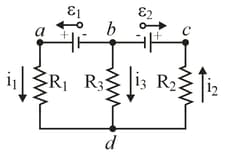Cells in Series and in Parallel
Important Questions on Cells in Series and in Parallel
Two cells, each of emf are joined in series and send current in an external resistor. If the same cells are joined in parallel, then they send current in the same resistor. What is the internal resistance of each cell?
Prove that two identical cells (each of emf , internal resistance ) will send same current in an external resistance whether all cells are connected in series or in parallel, if .
Find the emf and the internal resistance of an electric source which is equivalent to two batteries of emf's and and internal resistances and connected in parallel.
Find the emf of the battery shown in figure.

identical cells, each of emf E and internal resistance , are connected in series to a resistor . Deduce an expression for the internal resistance of one cell in terms of the current in the circuit.
In the Fig., what is the potential difference between the points and if and and the battery is ideal?

In figure, battery has and internal resistance and battery has emf and internal resistance . The batteries are connected in series with an external resistance . (a) What value makes the terminal-to-terminal potential difference of one of the batteries zero? (b) Which battery is that?

Find the emf and the internal resistance of a source which is equivalent to two batteries connected in parallel whose emf's are equal to and and internal resistances to and .
There are two cells of emf and and internal resistance and respectively connected in parallel. Then find out the equivalent emf and equivalent internal resistance of this combination. If external resistance is connected to this combination, then find out the value of electric current flowing through .
Six lead-acid type of secondary cells each of emf and internal resistance are joined in series to provide a supply to the resistance of . What is the current drawn from the supply and its terminal voltage?

